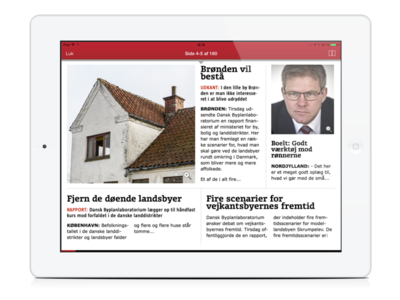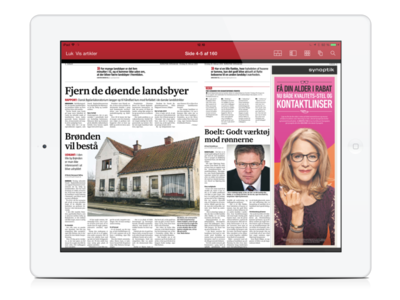Following a development partnership with Aarhus University and a number of European media houses, Visiolink is ready to launch a solution that automatically gives printed newspaper content a re-layout for the tablet.
According to a study conducted by Visiolink in collaboration with Aarhus University, readers tend to miss the underlying conventions of the printed paper on most digital platforms – particularly the editorial priorities and the structure of the paper's clear beginning, middle and end.These findings form the background for a newly developed solution, which automatically converts the layout of the printed paper to tablet format in newspaper apps. Based upon the articles placement, length and a number of other parameters, the system is able to prioritise and position the content.
"We believe that the printed paper is the best foundation for creating a paid digital product at the current time. In the long run, it will be completely natural to include live streaming and ever-so-gradually abandon the traditional newspaper format. For us, this is a transformational technology. A transition is underway from print to digital formats, and it is important to 'hasten slowly' in order for readers of the print edition to keep up," says Visiolink COO Kenneth Boll.
"This is why the solution is opening up gradually to new configuration and styling options. We're working with a flexible online platform, which makes it possible to add infographics, interactive ads and dynamic, updated content for the benefit of both readers and advertisers," Boll explains.


Main points
- Even before its launch date today at the Digital Media Europe conference in London, a new display format for digital newspapers has already been sold to more than 70 newspapers in Northern Europe.
- The solution makes it possible to convert the print elements from the media house's editorial system to an optimised display format for ever increasingly popular tablets, such as Apple's iPad. Using a range of parameters – such as photos, the number of words and the placement of an article – the system is able to automatically prioritise and position the content.
- The system maintains the editorial priorities, overview and flow of the printed newspaper, and it utilises the many new application and display options made possible by tablets in a full digital media platform.
- This means that media houses can allow readers to opt between two display formats for the same newspaper: AUTHENTIC – a 1:1 version of the newspaper; and DYNAMIC – a version in which articles, photos and graphics are automatically given a re-layout for the tablet screen.
- The solution was developed using studies undertaken in collaboration with Denmark's Aarhus University on which types of digital content future newspaper readers will be willing to pay for, and how that content can best be presented in tablets.
- The solution is based on elements and conventions taken from the printed newspaper, but as readers become more used to paying for digital products, media houses can open up to more integration of dynamic web content and advertising technologies.
Facts about the solution:
DYNAMIC functions as an alternative display of the publication's content. The content is delivered in XML format, which is produced in the editorial system. If an editorial system is not used, alternative options can be found to extract text and photos from the PDF. DYNAMIC is designed for iPhones and iPads and operates on iOS 7.
Toggle between the two viewing formats
At the top of the app, the reader has the option of switching between the two viewing formats. In DYNAMIC, the front pages of the newspaper's sections feature 3 to 4 of the most important stories from the entire section, and they are therefore not an exact copy of the front page from the 1:1 display; instead, they are something of a teaser for the section's top stories.
Selecting templates
Each screen display, or template, represents a spread of the printed newspaper. The layout of each template reproduces the editorial prioritisation of content in the corresponding spread. The priority is determined based on four parameters:
- Number of characters in the article
- Whether or not the article has an accompanying photo
- How high up on the page the article is located
- Whether the article is on the right or left side of the spread


